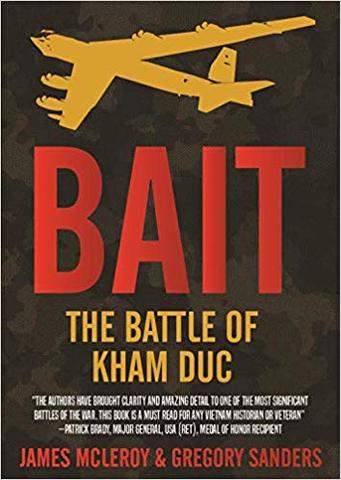Bait

Bait is an excellent book, and is so for a number of reasons. First off, without a doubt Bait provides a new look at a controversial battle that was fought during the Vietnam War; but It does something else as well. It provides a great new strategic perspective on the U.S. mid-late 1960's military approach to the Vietnam War in general. As if that were not enough it is also well written, and impeccably researched (as one would expect given one of the authors was a participant in this same battle).
Authors McLeroy and Sanders have crafted a compelling and clearly-written look at the little known battle that is the subject of this work: That being The Battle of Kham Duc. The battle occurred in May of 1968 and centers around an American Special Forces camp at Kham Duc as well as a related patrol base five miles south of it at Ngok Tavak - both located near the Laotian border of Quang Tin province, South Vietnam. In May of 1968 a small contingent of American ground forces and South Vietnamese irregular troops (albeit backed by absolutely massive amounts of air delivered firepower) would be ordered to retreat from the base after taking stiff losses while fighting off two full regiments from the North Vietnamese Army (NVA) who themselves were ultimately decimated (mostly by the immense concentrations of airpower the U.S. gathered over the battlefield) in the heavy fighting. Traditional explanations of this battle is that the American camp was overrun - however the authors show that such descriptions are not only simplistic but also misleading.
To bolster their arguments the authors provides an extensive look at the camp, the geography of the region, the camp's role in the larger war, the NVA approach, the American led defensive planning, the participants goals, combat, and implications of the battle. And it does all of this in an engaging and tightly written 272 pages that just about anyone picking up the book will devour in a single reading, as it is near impossible to put down. In particular, the author's anaylsis of the participants intentions and actions is comprehensive and unflinching. The authors are absolutely unafraid of naming exactly who involved in the battle failed when tested and who performed with valor in an incredibly difficult situation.
One of the many interesting aspects of this book is in its conclusions and argumentation advancing the point that in fact the battle was not a U.S. defeat, but part of a larger strategy that played a mostly effective tactical and even operational role in undermining the North Vietnamese war effort. Moreover, the authors ably show how North Vietnam's top military minds were sidelined prior to the war altering events of 1968 which should have been to the great detriment of the North Vietnamese strategic goals. Instead however the what was ostensibly premature North Vietnamese strategy as put forth its new architect succeeded in the face of an operational level near theater wide defeat via taking an important strategic step in fatally weakening U.S. political resolve to continue the war.
It must be said that I am not an expert on the Vietnam War. Nevertheless, there is nothing put forth by this work's authors that should be at all controversial to a person with a basic strategic, operational, or tactical understanding of waging war. This is even more so considering that the battle was fought under a very conventional set of circumstances in the spring of 1968 (with airpower doing what it does best in a tactical sense to an enemy pinned in the relative open) as part of what is widely misunderstood as a still very much irrelegular conflict by that time in Vietnam's long-slog toward ultimate unification.



Post new comment